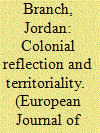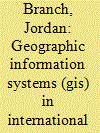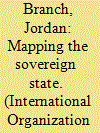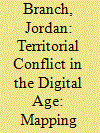|
|
|
Sort Order |
|
|
|
Items / Page
|
|
|
|
|
|
|
| Srl | Item |
| 1 |
ID:
113808


|
|
|
|
|
| Publication |
2012.
|
| Summary/Abstract |
The modern international system is commonly argued to have originated within Western Europe and spread globally during centuries of colonialism. This article argues, instead, that the character of the modern system of territorially sovereign states resulted from a complex interaction between European colonizing polities and events, actors, and spaces in other parts of the globe. In particular, through a process of colonial reflection, many of the foundational ideas and practices of modern statehood were formed in the interactions of Europeans with the unknown, supposedly empty, spaces of the New World in the 16th and 17th centuries. These novel practices were applied only later to politics among states in Europe. Most important among these developments is the ideal of territorial exclusivity as the sole basis for state sovereignty. This analysis also has implications for the study of contemporary international systemic change.
|
|
|
|
|
|
|
|
|
|
|
|
|
|
|
|
| 2 |
ID:
149133


|
|
|
|
|
| Summary/Abstract |
Geographic Information Systems (GIS) are being applied with increasing frequency, and with increasing sophistication, in international relations and in political science more generally. Their benefits have been impressive: analyses that simply would not have been possible without GIS are now being completed, and the spatial component of international politics—long considered central but rarely incorporated analytically—has been given new emphasis. However, new methods face new challenges, and to apply GIS successfully, two specific issues need to be addressed: measurement validity and selection bias. Both relate to the challenge of conceptualizing nonspatial phenomena with the spatial tools of GIS. Significant measurement error can occur when the concepts that are coded as spatial variables are not, in fact, validly measured by the default data structure of GIS, and selection bias can arise when GIS systematically excludes certain types of units. Because these potential problems are hidden by the technical details of the method, GIS data sets and analyses can sometimes appear to overcome these challenges when, in fact, they fail to do so. Once these issues come to light, however, potential solutions become apparent—including some in existing applications in international relations and in other fields.
|
|
|
|
|
|
|
|
|
|
|
|
|
|
|
|
| 3 |
ID:
102536


|
|
|
|
|
| Publication |
2011.
|
| Summary/Abstract |
This article examines the effect of cartography on the development of the modern state system. I argue that new mapping technologies in early modern Europe changed how actors thought about political space, organization, and authority, thus shaping the creation of sovereign states and international relations. In particular, mapping was fundamental to three key characteristics of the medieval-to-modern shift: the homogenization of territorial authority, the linearization of political boundaries, and the elimination of nonterritorial forms of organization. Although maps have been interpreted as epiphenomenal to political change, each of these three transformations occurred first in the representational space of maps and only subsequently in the political practices of rulers and states. Based on evidence from the history of cartographic technologies and their use by political actors, the practices and texts of international negotiations, and the practical implementation of linearly bounded territoriality by states, this article argues that changes in the representational practices of mapmaking were constitutive of the early-modern transformation of the authoritative structure of politics. This explanation of the international system's historical transformation suggests useful new directions for investigations into the possibility of fundamental political change due to the economic, social, and technological developments of globalization.
|
|
|
|
|
|
|
|
|
|
|
|
|
|
|
|
| 4 |
ID:
157353


|
|
|
|
|
| Summary/Abstract |
This article examines the central, though understudied, role that a rapidly changing technology—mapping—plays in territorial conflict. As digital cartographic tools replace traditional paper maps, both the processes and outcomes of negotiation over territory change fundamentally. Digitization does not simply produce “better” maps that make settlements easier to reach. Instead, particular features of digital mapping reshape disputes over territory by altering the evaluation of possible solutions, changing the perceived value of territories, and bringing new actors into negotiation processes. Those effects are complex and context-sensitive. They promote conflict resolution in some circumstances but pose new obstacles to settlements in others. This article combines theory on mapping, negotiation, bargaining, and emotions in international relations. I first develop a set of general implications of digital mapping for the processes and outcomes of territorial negotiation. I then examine three illustrative cases: the 1995 Dayton Accords, the Eritrea-Ethiopia Boundary Commission, and the 2010 border dispute between Costa Rica and Nicaragua. In each case, new features of digital mapping yielded unexpected effects on negotiation and dispute-resolution processes.
|
|
|
|
|
|
|
|
|
|
|
|
|
|
|
|
| 5 |
ID:
177782


|
|
|
|
|
| Summary/Abstract |
For more than a decade, the United States military has conceptualized and discussed the Internet and related systems as “cyberspace,” understood as a “domain” of conflict like land, sea, air, and outer space. How and why did this concept become entrenched in US doctrine? What are its effects? Focusing on the emergence and consolidation of this terminology, I make three arguments about the role of language in cybersecurity policy. First, I propose a new, politically consequential category of metaphor: foundational metaphors, implied by using particular labels rather than stated outright. These metaphors support specific ways to understand complex issues, provide discursive resources to some arguments over others, and shape policy contestation and outcomes. Second, I present a detailed empirical study of US military strategy and doctrine that traces the emergence and consolidation of terminology built on the “cyberspace domain.” This concept supported implicit metaphorical correspondences between the Internet and physical space, yielding specific analogies and arguments for understanding the Internet and its effects. Third, I focus on the rhetorical effects of this terminology to reveal two important institutional consequences: this language has been essential to expanding the military's role in cybersecurity, and specific interests within the Department of Defense have used this framework to support the creation of US Cyber Command. These linguistic effects in the United States also have implications for how other states approach cybersecurity, for how international law is applied to cyber operations, and for how International Relations understands language and technological change.
|
|
|
|
|
|
|
|
|
|
|
|
|
|
|
|
|
|
|
|
|